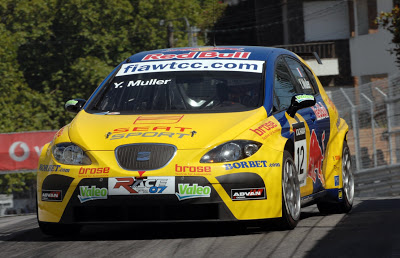SEAT Becomes First Carmaker To Put Diesel Into WTCC
 Just like Audi presented the R10 TDI –the world's first
Just like Audi presented the R10 TDI –the world's first
Despite facing a double handicap with the diesel car since, according to regulations, a diesel-powered car has to weigh 30 kg – 66 lb more than one with a petrol engine along with the fact that the intercooler and the turbo are situated ahead of the front axle, thus distorting even weight distribution, the Seat team has faith in the project. After seeing what Audi accomplished with the R10 TDI, who can blame them. -Continued: Click “Read More…†below
Jaime Puig, Director of SEAT Sport: ‘The regulations allow us to register a car equipped with a diesel engine, and we were happy to rise to the challenge. We are satisfied with the testing results and believe the Leon TDI WTCC can become a competitive car in the mid to long term. For the moment it will only be driven by Jordi Gené, who has been responsible for its development, and Yvan Muller. Gabriele Tarquini, Tiago Monteiro and Michel Jourdain will continue to drive the usual model.’
Benoit Bagur, SEAT Sport Chief Engineer: ‘Since the FIA made it possible to enter a diesel engine in the competition, we started looking into the viability of the project, and it took off a few months ago. The basis for the engine is the 170 PS 2.0-litre mounted in the Leon FR. We kept the engine block and the cylinder head of the production model, but changed the turbo compressor and gearbox. Furthermore, we had to alter the front part to house the intercooler and create new air intakes. The diesel engine is 35 kg heavier than the petrol, so we had to redistribute some weight. After satisfactory test results, we are eager to see its potential in actual racing conditions.’
Jordi Gené, SEAT driver: ‘We have been working on this project for several months, and appreciate its great potential. I am looking forward to it because one of the aspects I most like about my job is the possibility of working on new car development, and even more so when they feature new technology. We are facing a double handicap with the diesel car. The first is that according to regulations, a diesel car has to weigh 30 kg more than one with a petrol engine. The second is that the intercooler and the turbo are situated ahead of the front axle, which makes weight distribution detrimental compared with a petrol car. But, as the Leon has the best chassis in the Championship and our engine torque will be much higher, I think that, in the mid-term and on certain tracks, we can be competitive.’
Yvan Muller, SEAT driver: ‘I have done some testing with the diesel engine, and the lap times are very similar to the petrol. It is a little slower in the corners because of the extra weight and there is more stress on the tyres, but it is a little bit quicker on the straights. The chassis of the SEAT
SEAT
BASE CAR
- SEAT Leon FR 2.0 TDI 170 PS
ENGINE
- Turbocharged, four-cylinder in line, transversely-mounted, 16 valves,
- twin overhead camshafts
- Displacement: 2,000 cc
- Bore x stroke: 81 x 95.5 mm
- Maximum power: 280 PS at 4000 rpm
- Maximum torque: 450 Nm at 2500 rpm
- Lubrication: wet sump
TRANSMISSION
- Front-wheel drive
- Gearbox: Hewland six-speed, sequential shift
- Clutch: twin-plate
- Differential: mechanical limited slip differential
CHASSIS
- Front suspension: MacPherson strut, coil springs, gas-filled dampers, anti-roll bar
- Rear suspension: multi-link axle, coil springs, gas-filled dampers, anti-roll bar
- Steering: power-assisted rack and pinion
BRAKES
- Non-assisted dual circuit system
- Front brakes: four-piston callipers, 332 mm steel ventilated discs
- Rear brakes: two-piston callipers, 280 mm steel discs
DIMENSIONS
- Length: 4330 mm
- Width: 1849 mm
- Wheelbase: 2600 mm
- Minimum weight: 1170kg (including driver)
- Seat Uk Expands Availability Of Fr Trim, Introduces New Fr+ And Upgrades Cupra R In The Leon's Range
Banking on the success of the Leon FR that, last year, was responsible for one in four Leon sales in Britain, Seat introduced a new FR+ derivative, while also extending the FR badge to a broader engine range. The Leon FR hatch is now available with...
- Geneva Preview: 2009 Seat Leon Facelift With Styling Tweaks And Revised Engines
At next month's Geneva Motor Show SEAT will showcase the facelifted Leon hatchback featuring minor cosmetic revisions and an updated engine range. On the outside the most identifiable traits of the 2009 model concern the newly shaped grille with the...
- Seat's Leon "twin Drive" Petrol-electric Hybrid
Seat has revealed a new prototype version of the Leon hatchback conceived to run on electric power or a conventional petrol engine. As its name suggests, the Leon "Twin Drive" Ecomotive sports a hybrid powertrain that consists of a 35 kW electric motor...
- Porsche Updates The 911 Gt3 Rsr For 2009
The most powerful race-spec 911, the GT3 RSR which is designed to compete in the GT2 class at international long distance races, has received a series of modifications for the 2009 model year. The updated 911 GT3 RSR features a more aerodynamic body,...
- Seat Leon Tdi Scores Historic First Wtcc Diesel Win
Following Audi’s success with the diesel powered “R10†and barely a month after the Spanish firm announced that it’ll enter the FIA World Touring Car Championship with the Leon TDI, Seat became the first manufacturer to win...
